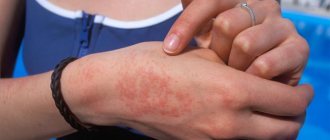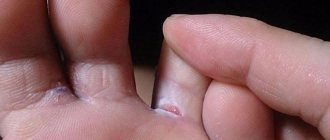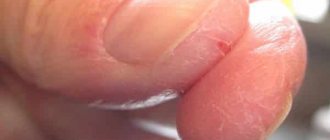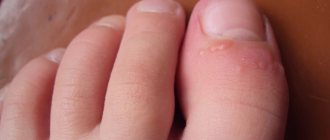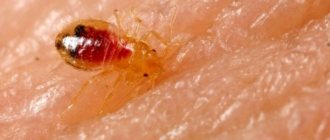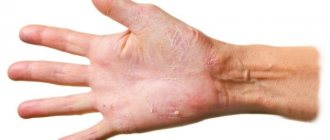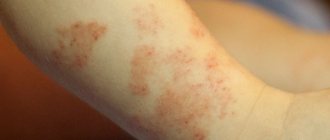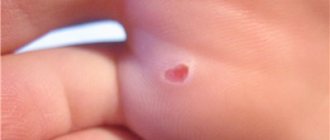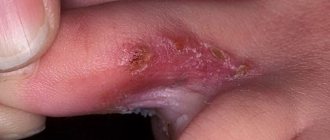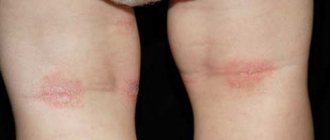The skin between the fingers, not including the intimate areas, is the most delicate part of the human body. Short-term itching in this area can occur for no noticeable reason and disappear just as imperceptibly. If irritation between the fingers is accompanied by a rash, redness or peeling, treatment cannot be avoided.
- Quick navigation through the article:
- Causes of irritation between fingers and symptoms
- Other reasons
- Treatment
- What will happen if left untreated?
- Diet against irritation on hands
- Preventing irritation between fingers
- Reviews
Dry skin
One of the reasons for the itching that bothers the patient between the fingers during the day is dry skin. This feature can bother an absolutely healthy person if there is a hereditary predisposition. At the same time, close relatives have thin and sensitive tissues. Other factors are also noted:
- tendency to allergic pathology;
- insufficient intake of vitamins into the body;
- iron deficiency;
- excess of certain vitamins.
Excessive peeling of the skin on the fingers leads to a decrease in skin immunity. Violation of protective mechanisms increases the risk of various infections. The penetration of pathogenic pathogens is facilitated by the appearance of microcracks in the epidermis, given the favorable background for their reproduction.
Therefore, the main task in the presence of dryness is to restore the dermis and epidermis. The main method of therapy is proper care of the skin of the fingers. To do this, they resort to the following means:
- baths with herbal decoctions;
- nourishing oils enriched with vitamins and mineral complexes;
- special ointments, creams and gels.
In individual cases, in order to achieve healthy hand skin, the doctor may prescribe drug therapy, which includes:
antihistamines, anti-inflammatory, subsidized vitamin preparations.
Causes of itching
Itching in the fingers can be caused by both natural factors, which can be corrected at home, and various health problems. This symptom is sometimes provoked by:
- Allergic diseases.
- Various fungal infections.
- Scabies, etc.
It is quite difficult to independently determine what exactly caused the obsessive itching in the fingers. Only an experienced doctor can make the correct diagnosis.
Natural factors
Irritation, peeling and itching in the area of the fingers and between them can be a consequence of:
- Insufficient proper hand care, irregular use of moisturizer, etc.
- Temperature fluctuations, especially during the cold season.
- Dehydration, especially when used for washing with hard water.
- Unstable psycho-emotional state, in particular, lack of sleep, prolonged stress, chronic fatigue and stress.
- Lack of proper nutrition, which negatively affects the general condition of the body. The thin skin between the toes may be one of the first to react to such changes.
- Age-related changes. In older people, the skin becomes very dry, itchy and may even crack. The main reasons for such changes are local dehydration, decreased collagen synthesis, and a deterioration in the ability to absorb nutrients from food.
Sometimes it is quite possible to correct the causes of itchy skin on the hands on your own at home. To do this, it is important to provide your hands with comprehensive and proper care, and yourself with a balanced diet and a comfortable psycho-emotional state.
Skin becomes red and flaky due to allergies
Contact allergies most often appear on the skin of the hands, which occurs as a result of direct contact with allergens, for example, chemicals in washing powder, dishwashing detergent, etc. Hands can also be the first to react to new care products - creams and gels, or medications for local application. Among the obvious signs of allergies:
- Redness. It can be focal in nature - look like limited spots, or be more diffuse.
- Swelling of tissues.
- Severe itching.
- Rashes - small pinpoint rashes, sometimes - blisters, similar to nettle burns.
If you have an allergy, the skin on your hands may become hot to the touch. Sometimes damage appears on it - cracks and sores. Most often, such symptoms are observed with a prolonged course of allergies, when the patient continues to come into contact with the allergen for some time after the first signs of the disease appear.
Allergic dermatitis can cause a lot of discomfort. Therefore, when its symptoms first appear, it is better to seek medical help to identify the allergen and prescribe adequate therapy.
Severe itching due to scabies
Scabies is a common parasitic disease that occurs due to infestation by scabies mites. This is a small parasite that gnaws through scabies in human skin to lay eggs. Possible signs of the disease include:
- Intense skin itching, which greatly intensifies at night, disturbing the patient’s sleep.
- The appearance of a small inflammatory rash.
- The appearance of scabies on the skin, which are clearly visible under magnification, but sometimes visible to the naked eye - they can look like stripes, no more than 0.5 cm long. Such areas are felt when stroking the skin, like small elevations.
- Scratching in affected areas, where inflamed sores may appear.
From the skin between the fingers, mites easily spread to the wrists, and subsequently to the elbows, mammary glands, groin skin (in men, the penis and scrotum are affected), etc. Diagnosis of the disease is not difficult for a dermatologist.
Irritation and red spots due to fungus
Various fungal diseases are quite often localized on the hands, and may well affect the skin between the fingers, causing intense itching and other health problems. Most often, a person lives happily alongside fungal organisms, and they do not cause him any inconvenience. But with a general and local decrease in immunity, fungi begin to actively multiply, which becomes the cause:
- Itching, which forces you to gradually scratch the affected areas, which leads to irritation and injury to the skin.
- The appearance of bubbles filled with liquid.
- Formation of wounds and cracks.
- The occurrence of erosions and swelling.
Some pathogenic fungi are transmitted to people from animals, in which case there is a risk of developing lichen between the fingers. With this disease, a red spot may appear on the skin, which stands out noticeably against the background of the surrounding epidermis. This type of disease is considered quite contagious.
Sometimes the fungus makes itself felt only by itching and the appearance of powdery peeling of the folds between the fingers. In the absence of adequate therapy, the disease can spread to other areas of the hands, including the nail plate.
Why does a child itch?
Children are much more vulnerable to various bacteria, viruses and fungi than adults. But in a child, itching and/or peeling between the fingers is most often a consequence of:
- Proper hand care is not enough. Kids don’t always like to wash their hands and, even more so, are often too lazy to wipe them dry. If moisture always accumulates in the spaces between the fingers, the skin can dry out and peel. Itching in this case is a secondary symptom and occurs as a result of dehydration of the epidermis.
- Allergies. In children, redness and peeling on and between the fingers can be a sign not only of contact allergies, but also of intolerance to certain foods. At first, such a disease can only be signaled by severe peeling of the skin, which causes itching and discomfort. Subsequently, it is accompanied by a small rash or reddish spots.
Other conditions that cause itching and flaking on the hands of adults are much less common in children. However, only an experienced dermatologist can identify the exact cause of the discomfort.
Causes of redness without itching
Sometimes the condition of the skin on the hands between the fingers deteriorates greatly, but is not accompanied by obvious health problems - pain or itching. Most often, this situation is a consequence of:
- Improper hand care. The skin may react with redness to too hard and chlorinated water, low-quality soap and improperly selected cream. Sometimes redness occurs when washing hands with too cold or, conversely, hot water. It can also be triggered by the habit of not drying your hands completely or washing dishes without gloves, etc.
- Hypovitaminosis. If the body lacks certain nutrients, the skin can become irritated and even inflamed. At the same time, it is difficult to determine exactly what substances the body needs. Redness can be caused by a deficiency of vitamin E, vitamin A, B vitamins and many other substances.
- The initial stage of development of some health problems. In this case, redness will soon be complemented by other health problems.
- Chronicity of some dermatological diseases. In particular, allergic dermatitis without an exacerbation or a chronic fungal disease may not cause discomfort, but look like red spots between the fingers.
If redness does not cause discomfort, it is worth establishing skin care first. But if the unpleasant symptom does not disappear, you should consult a dermatologist to identify possible health problems.
Itchy toes
The appearance of itchy sensations in the spaces between the toes, as well as on the toes themselves, can be a consequence of:
- Fungal diseases. In this case, the unpleasant symptoms may be complemented by redness and peeling of the skin, as well as an unpleasant odor from the feet.
- Increased sweating.
- Wearing low-quality socks or shoes.
- Allergies to local products - creams, ointments, etc. In this case, redness, small rashes and peeling may be detected on the skin. Sometimes doctors are faced with the development of contact dermatitis as a result of an individual reaction to individual chemical compounds included in the shoe materials.
- Obesity and some anatomical features. If your toes are closed very tightly (which is often the case if you are overweight), your skin may become constantly sweaty, itchy, and flaky.
- Diabetes mellitus. With this disease, the condition of the skin is greatly disturbed, and often this first appears on the skin on the legs. It can peel, itch, crack and become covered with erosions. This condition is very dangerous, as it can lead to infection, necrosis, etc.
Itching between the toes is a serious reason to visit a dermatologist or podiatrist. Most often, this condition indicates fungal diseases, and therefore requires timely diagnosis and treatment.
Allergic conditions
Itching between the fingers is the main symptom of an allergic condition. The pathology occurs in young children and older people. Children are more likely to suffer from atopic dermatitis, which is associated with high sensitivity to food. In adults, other factors may cause adverse symptoms. There are the following causes of an allergic skin reaction on the hands:
- Accidental or constant contact with chemicals - household chemicals, detergents.
- Individual reactions to certain metals, natural wool or synthetic fabrics.
- Eating foods that contain triggers - chocolate, citrus fruits, chicken, orange and red fruits, seeds, nuts, honey.
- Genetic predisposition - if first-degree relatives have allergies, the probability of developing the disease in their offspring reaches 90%.
- Exposure to unfavorable environmental factors, which lead to a decrease in the body's defenses and the formation of autoimmune reactions.
Allergic dermatitis manifests itself as a pinpoint or spotty rash, redness and itching between the fingers, on the hands, and in the folds. Treatment includes the prescription of antihistamines and hormonal drugs, as well as dermal care.
Itchy blisters on fingers
External
- household chemicals, building mixtures, chemicals;
- dust, dirt;
- severe frost, off-season;
- prolonged contact with water.
Internal:
- scabies mite infection, fungal infection, rubella, measles, chickenpox cause small watery pimples;
- pronounced emotional states, nervous overstrain;
- disorders of the digestive system;
- weakened immune defense, vitamin deficiency;
- lack of sleep, poor lifestyle;
- burns of some plants (hogweed, hemlock, nettle);
- taking certain medications.
Fungal diseases
Violation of the skin barrier function can facilitate the penetration of pathogenic microorganisms into the deeper layers. If it itches between the fingers for a long period of time, an infectious disease should be suspected. This pathology includes mycoses. The most common pathogen is Candida albicans. This is due to the fact that the fungus is normally present on the surface of the skin of the fingers and is part of the biocenosis of every person.
However, against the background of unfavorable factors, rapid growth of the mycelium is noted, which leads to the occurrence of the disease. The following conditions contribute to increased reproduction:
- violation of tissue integrity - microcracks, abrasions, minor injuries, cuts;
- increased hand humidity - for example, when working for a long time in rubber gloves;
- allergic rash;
- congenital dryness and peeling of fingers.
Under certain conditions, fungi penetrate into the deeper layers. The mycelium actively grows, which leads to the appearance of unfavorable symptoms. There is redness and itching between the fingers, which does not go away with standard therapy. Subsequently, the process covers large areas of the skin, which causes subjective discomfort and cosmetic defects.
Attention! A specialist should determine the cause of itching between the fingers by scraping the pathologically altered skin.
After receiving a positive result of an additional examination, the doctor prescribes etiological therapy. If fungal spores are detected, hand care products are not sufficient. Fungal drugs for local use and oral substances are prescribed.
Allergy between fingers
When an allergen enters the body, the immune system begins to neutralize this process by producing special antibodies. The occurrence of allergies between the fingers is a reaction of the body to irritants of a different nature. The worst case scenario is that the watery blisters begin to burst, causing severe discomfort to the person.
- Close contact with household chemicals and cleaning agents.
- Genetic predisposition of the body, allergic reaction to cold, wind, rain.
- Allergic rashes can be triggered by a stressful situation, contact with water, soil, or increased sweating.
Parasitoses
When itching between the fingers, mainly at night, there is a possibility of a disease such as scabies. The mite penetrates into the deep layers of the dermis, causing manifestations that mimic allergic diseases. If a person does not see a doctor in time, the process spreads to other parts of the body - the abdomen, limbs.
In severe cases, complications may occur in the form of a bacterial or fungal infection. The parasite moves in the skin at night. The larvae and waste products of scabies mites enter the dermis and cause severe itching. Therefore, the patient wants to scratch himself at this time. In addition, the following signs of the disease are noted:
- peeling of the top layer of skin;
- the presence of paired passages on the surface of the dermis;
- hyperemia in the place where the fingers itch;
- serous discharge at the site of the rash.
The infection provokes the development of a secondary allergic condition. However, antihistamines are ineffective - the skin continues to itch. If scabies is suspected, the patient is examined by a dermatologist, who prescribes therapy and develops preventive measures for all family members, taking into account the high contagiousness of the disease.
Treatment for scabies mites
If the skin between your fingers is very itchy, the presence of subcutaneous parasites cannot be ruled out. One of them is the scabies mite. The itching is caused by his bites. Females gnaw passages in the subcutaneous space and lay eggs there.
Itching of the hands between the fingers is treated only after a tick is detected. Therapy will continue for 2 weeks. This is necessary to destroy the entire parasite population. Typically, benzyl benzoate-based products are prescribed.
The ointment is applied directly to the skin between the fingers. The disadvantage of such products is their high toxicity. Sulfur ointment effectively relieves itching; it is an inexpensive remedy that is available in every pharmacy.
Spregal is an anti-scabies agent in aerosol form. Ticks die after a single treatment, but symptoms may persist for a week. During treatment, bedding and clothing of all family members should also be treated. This will avoid re-infection.
To treat scabies, water-soap solutions and oil emulsions with benzyl benzoate and the addition of anesthesin are used. When used for the first time, such external preparations cause the death of all parasites that are in the active stage.
To eliminate mite larvae, the skin is re-treated on the fourth day of treatment. The disadvantage of this drug is its aggressive effect on the dermis, which is manifested by dryness and irritation of already injured skin.
Preparations based on pyrethrins (Permantrin) do not have a toxic effect, and also eliminate both larvae and adults with a single use. No less effective is Spregal spray, which is prescribed for extensive localization of ticks on the surface of the body.
Outdated methods of combating scabies include sulfur ointment, Lindane and Crotamion (Yurax) due to side effects, including neurotoxic effects, erythema, conjunctivitis, and complications of kidney function.
Autoimmune disorders
Sometimes it itches between the fingers for no apparent reason. If the doctor has ruled out an infectious pathology, then there is a possibility of developing an autoimmune disease. In this case, it is very difficult to determine the provoking factor. The disease manifests itself:
- itching between the fingers;
- hyperemia of the skin at the folds;
- peeling of the epidermis.
In order to differentiate the pathology, you need to consult a specialist. After excluding infectious causes of the disease, additional examination is prescribed to confirm the diagnosis. Treatment of itching between the fingers caused by an autoimmune factor is based on the degree of activity of the process and the severity of the patient's condition. Pathogenetic anti-inflammatory and cytostatic therapy is carried out.
What are the dangers of lack of treatment?
Pathology cannot be ignored, because it can become chronic. Treatment of irritation between the fingers is prescribed individually by a doctor. Contacting a specialist depends on the nature of the disease. For example, if the provoking factor is problems with the gastrointestinal tract, then you should go to a gastroenterologist.
- Soothing baths with a decoction of chamomile, oak bark, and chamomile herbs are recommended if the root cause of the pathology cannot be identified.
- If the rash and itching affect not only the hands, then the doctor will recommend taking antihistamines, vitamins, and general calcium supplements.
- In old age, medications with iodine will help get rid of itching.
- In severe cases of the disease, corticosteroid ointments, gels and drugs that are designed to relieve inflammation and irritation may be prescribed.
The danger of skin diseases is often underestimated, perceiving dermatological pathologies solely as a cosmetic problem that poses a threat only to appearance. Often, such careless attitude towards skin health can lead to serious consequences. Fungal diseases are especially dangerous, poisoning the body and harming other organs.
Timely treatment is the way to avoid serious consequences and complications. An advanced disease is a threat both to your wallet (the more advanced the disease, the more difficult, and therefore more expensive, treatment) and to your health.
Directions of therapy
Methods of help depend on the causes of itching between the fingers. The main directions are:
- local drugs;
- medications for oral administration;
- hand skin care - baths, creams with urea, lipid and mineral components.
The scope of therapeutic measures is determined by the attending physician. The course depends on the type of disease. In some cases, proper care of the dermis is sufficient. However, in difficult situations it is necessary to treat the patient using an integrated approach.
Medications
The following medications will help eliminate the unpleasant symptoms of dermatitis and redness, especially if your hands are very itchy:
- Local antihistamines and oral forms - when a rash or eczema appears, the drugs reduce swelling, hyperemia, and reduce discomfort.
- Hormones - used to treat severe forms of allergies and autoimmune diseases. They are applied locally and taken orally. At the present stage, preference is given to drugs with a high degree of activity and fewer adverse reactions. Good results from using Uniderm cream and ointment based on mometasone.
- Cytostatics - used for autoimmune pathology, psoriasis; and analogies are used to prevent the development of the process.
- Antifungals - prescribed by a dermatologist for mycoses.
- Antiparasitic agents - recommended for scabies. They are produced in the form of benzyl benzoate emulsion or Spregal spray.
- Drugs that improve the quality of the dermis - products are prescribed that contain urea, lipid components, and liquid paraffin. They restore the epidermis and promote cell regeneration.
Important! The dose and frequency of treatment is determined by a specialist, depending on the severity of the patient’s condition.
Pharmacy remedies for itching
There are many medications used to relieve itchy skin.
- Creams, ointments, pastes. For external use I use Nezulin gel. It has anti-inflammatory, antipruritic effects, and also increases the immunity of the skin. Wilkinson's ointment, Sulfur ointment, Citrine - antihistamines - help cope with itching and skin irritation due to scabies and other diseases.
- Tablets - antihistamine, hormonal, antifungal. If itching occurs due to allergic reactions, antihistamines are used. Suprastin, Tavegil are available in tablet form. You should take 1 tablet 3 times a day. Loratadine is also an antiallergic drug. Its advantage is that it comes in syrup form and can be used in childhood. If itching develops due to diabetes mellitus or kidney disease, hormonal treatment with prednisolone is recommended. It has an anti-inflammatory effect and eliminates itching. Hormonal drugs are sold in pharmacies only with a doctor's prescription.
Traditional methods of treatment
If the skin itches, irritation appears. Treatment of itching between the fingers and redness may involve the use of traditional methods. Recipes that are prepared at home have proven themselves well:
- Blueberries - lightly boil and knead until smooth. The resulting mass is applied as a compress to the site of inflammation on the arm for 1-2 hours.
- Soda solution - add one tablespoon of baking soda to 1 liter of warm water. Make baths or wipe the skin with it.
- Olive oil - nourishes tissues well, eliminates dryness and irritation.
- Carrots - applied in the form of a paste to the affected area on the fingers.
- Tangerine juice helps with fungal diseases.
- Baths made from a decoction of birch stems and leaves - eliminates inflammation and itching on the hand.
An effective result depends on proper therapy. Therefore, if itching occurs, you should consult a doctor who will prescribe treatment depending on the cause of the disease, the severity of the condition and the individual characteristics of the patient.
First aid
If redness and blisters between your fingers itch, it means you need to take action urgently. Be sure to see a doctor right away to avoid making your problem worse and harming others.
It is best to stay at home during treatment. To prevent itching between your fingers from being so annoying, take note of a few tips:
- If the spot between your fingers itches, you can reduce the sensitivity with ice. Wrap it in cloth and apply it to the area that is bothering you.
- Take three hundred grams of oatmeal and fill it with two liters of hot water. Let the prepared mixture cool, and then immerse your hands in it and hold for about half an hour.
- Try to limit the use of chemicals (especially detergents and powders). Wash your hands in warm water. It is better to forget about cold and hot during treatment.
